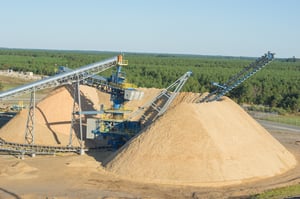8 min read
WSJ’s Incomplete Reporting Perpetuates Misconceptions About Bioenergy
 Stan Parton
:
August 22, 2019
Stan Parton
:
August 22, 2019

A recent article published in the Wall Street Journal notes that the increased consumption of wood pellets in the European Union (EU) is an issue that continues to inflame tensions and, this time, the escalation has made its way to Europe’s General Court. This is a noteworthy development for the international wood pellet trade, as the EU consumed over 27 million metric tons of pellets in 2018—nearly 75% of global demand.
“The lawsuit was filed by a group of scholars, advocacy organizations and European and U.S. landowners who want the EU to make the burning of forest wood ineligible for member states’ renewable-energy targets and subsidies,” writes the article’s author and summer intern for the WSJ, Charlie McGee. He continues, “The defendants, the European Parliament and the European Council, say the plaintiffs don’t have standing in the suit because they aren’t directly impacted. The plaintiffs have to file a response by Aug. 21.”
I am not surprised that the topic of wood pellets has made its way back to the courtroom or the newspapers. As we have noted before, the bioenergy space is often misunderstood by the general public because only slices of the full picture are offered by members of the news media. While Mr. McGee gives a fair accounting of both sides of the larger wood pellet debate, there are nevertheless several misconceptions that remain pervasive among the public due to incomplete reporting, including this article.
Understanding Energy and Carbon Emissions
As a society, we primarily use energy for two purposes—transportation and electricity. We generate this energy through various means: solar, wind, hydropower, wave power and thermal (geothermal, nuclear and combustion of carbon chains). For thermal generation, we use a heat source to heat water to generate steam, which then powers turbines that generate electricity. Of these energy sources, only the combustion of carbon chains produces carbon emissions.
There are only two sources of carbon: below-ground, sequestered fossil carbon, and above-ground biological carbon. When fossil carbon (oil, coal, natural gas) are combusted, the carbon is emitted and added to the atmospheric carbon level and are the major source of greenhouse gas (GHG) that contribute to climate change. Currently, 65% of US electricity is generated using fossil carbon sources (coal and natural gas), and almost 100% of our transportation fuels are derived from fossil carbon.
What Happens When We Burn Carbon Compounds?
When we burn (oxidize) the fuel (fossil or biomass), the process breaks the chemical bond between the carbon and oxygen atoms and that split releases thermal energy. The chemical bonds in the carbon chain can be either a single bond (one shared electron) or double bonds (two shared electrons). Breaking double bonds releases more energy than breaking single bonds. This is important because fossil fuels have a higher content of double bonds than does biological carbon. Thus, fossil fuels are more “efficient” in that there is more energy generated per unit of mass burned compared to biomass carbon.
This is an important point of misinformation in the global energy debate. Opponents of biomass po wer (including wood pellets) assert that biomass emits more carbon than fossil fuels. If we draw the boundary around the power plant itself, that is true because biomass has fewer double bonds than fossil carbon. However, we must remember that ALL of the fossil carbon is emitted as net carbon addition to the atmosphere (taking carbon that was sequestered below the ground and putting it into the atmosphere).
wer (including wood pellets) assert that biomass emits more carbon than fossil fuels. If we draw the boundary around the power plant itself, that is true because biomass has fewer double bonds than fossil carbon. However, we must remember that ALL of the fossil carbon is emitted as net carbon addition to the atmosphere (taking carbon that was sequestered below the ground and putting it into the atmosphere).
Conversely, biomass carbon originates above the ground and the carbon emitted is part of the balanced above-ground carbon cycle, i.e. the emitted carbon (and yes, there is slightly more per unit of electricity generated) is recaptured in new biological growth (trees in the forest, for example). Therefore, the only net carbon addition resulting from the combustion of biological carbon is the FOSSIL fuels required to harvest, process and transport the biomass fuel. This is why biomass carbon emissions are treated as near neutral with respect to net carbon emissions: carbon emitted ~= carbon reabsorbed.
For transportation, we can combust carbon-based fuels in internal combustion engines (again by breaking chemical bonds in the molecules) or by using electricity-powered vehicles whose batteries are fueled via the power grid, unless they are tied to dedicated solar panels (Tesla charging system, for instance).
What Are Some Other Primary Points of Misinformation About Biomass Energy?
- False claim #1: The use of biomass for energy results in depleting forest resources.
Most opponents of biomass energy have an incorrect view that timberland (the forest) is a pristine, untouched reserve in a static state. However, human civilizations have relied on the raw materials derived from working forests for millennia. The manufacture of wood products continues to support our society in many beneficial ways: housing/building products, paper products, textiles, chemicals, and a myriad of other products. In the US South—which is the primary source of wood pellets that are being shipped to the EU and Asia—the majority of timberland is owned by private individuals.
Because of concerns about the growth of the wood pellet industry in the US, Forest2Market was commissioned to examine the history and sustainability of the US forest as policy support in 2017. For the study, we conducted a statistical analysis for a 70-year period of the forest acreage, demand and inventory, and we found some very interesting and counter intuitive statistically significant correlations.
Over the period from 1953-2015 in the US South:
- Timberland acreage remained approximately constant within 3% (during the period, urban expansion took some forestland but at the same time, due to the expansion of corporate farming, small family farms now untilled returned to forest essentially offsetting urban expansion)
- Population increased significantly in the south
- Substantial economic growth occurred resulting in an increased demand for housing/lumber and paper and other forest products such as furniture
- This increased population and economics resulted in nearly doubling the timber harvested from privately-held timberland
With this confluence of factors, one would assume that the timber inventory would be diminished. However, our findings demonstrated the opposite. During this time period, we saw a DOUBLING of forest inventory (which, of course, is sequestered carbon). The statistical correlation is that increased demand results in increased inventory, not the opposite. Why did (and does) that happen?
Timber and the land the timber is on are economic assets. When there is a market for such assets, owners actively manage these assets to maximize economic return. During this period of economic growth and demand, timberland owner figured out how to increase the productivity (tons available per acre) by more than double, primarily through advanced forest management techniques and high yield pine plantations. The growth of the wood pellet industry, therefore, has created new demand for timber, which has resulted in an increase in inventory rather than a reduction in inventory.
It is worth noting that the wood pellet industry does not solely use timber in its manufacturing process, either. Much of the pellet feedstock material consists of wood chip residues generated from other wood products manufacturing processes. Additionally, some of the wood being supplied to pellet producers is in areas where demand for small-diameter timber (pulpwood) has decreased due to the systemic reduction in demand for printing and writing papers.
It’s also important to keep the scale of the wood pellet industry in perspective. In the US South, approximately 250 million tons of logs are harvested each year. Approximately 151 million tons go to pulp and paper mills; approximately 93 million tons go into dimensional lumber and panel/plywood production; and less than 10 million tons of roundwood go into the production of wood pellets.
The wood pellet industry is dwarfed by the traditional forest products industry. While there has been a decline in printing and writing papers, the growth of ecommerce has greatly increased the demand for packaging and shipping boxes.
False claim #2: The use of biomass for energy results in a carbon deficit
The forest product industry rightly claims that trees harvested are replaced with new trees. Obviously, mature trees are harvested and small seedlings are planted in their place. Some environmentalists claim that, while trees do grow back in time, it takes decades for each harvested tree to be replaced. That is a true statement, however, it is an incorrect assessment of what is occurring on a landscape or regional level where there is a continuum of planting, managing, thinning and harvesting taking place. So, what really matters is whether forest inventory is increasing or decreasing in a region. As stated above, we are currently growing more volume of trees than is being harvested and, therefore, there is no carbon deficit when viewed at the proper landscape level.
The role of biomass energy in the energy generation portfolio
Solar and wind energies are great zero-carbon sources of energy. However, they are intermittent sources that are reliable only when the sun shines or the wind blows. There will continue to be a need for “baseload” power, which is energy that is generated on-demand/as needed from a fuel source (coal, oil, natural gas, nuclear and biomass); this type of energy constitutes the clear majority of our electrical generation. While responsibly pursuing new energy alternatives and expanding our energy portfolio is extremely important, we cannot lose sight of the enormity and cost of the task, which is essentially replacing most of our national and global electricity generating systems. Consider the scale and cost that would be required to do so within a 15 to 30-year period.
Most coal power generation utilizes a Pulverized Coal (PC) fuel infeed system. Coal chunks are crushed in pulverizers and the coal dust is blown into the boiler as a suspended atomized “gas” stream. Wood pellets can replace coal in PC systems. Wood pellets are manufactured by taking wood and grinding it down to a fiber level, then recompressing the wood fibers into pellets. When fed into a pulverizer system, the pellets break down to the fiber level and can be blown into the boiler just like coal dust. This allows the same power generating infrastructure to be used, thus avoiding the tremendous cost of replacement. The viability of this approach as significant scale has been demonstrated in the UK.
Biomass power isn’t the total solution to addressing climate change. However, it can be a bridge energy source and key portion of the solution by providing a near zero-carbon addition alternative that can also be implemented at large base-load capacity.
The relative cost of renewable energy
This topic is germane for both fossil electrical power and fossil transportation fuels. It can be correctly stated that renewable energy is more expensive compared to fossil fuel energy. As mentioned above, one reason for that is the higher thermal content of fossil fuels compared to biomass. We can’t do anything about that since it is established by the chemistry of the fuels. But there are two other major factors that contribute to the cost differential which must be considered. We have long made the argument that renewable energy isn’t too expensive; fossil energy is artificially too cheap! The two factors driving this are 1) favorable financial treatment of the fossil energy industry, and 2) no allocated societal cost ascribed to fossil energy for the cumulative results from its net carbon addition.
- Favorable financial treatment: One of the roles of government is to assist in supporting nascent industries that provide a benefit for the population. This assistance typically comes by way of favorable tax incentives and capital utilization such as accelerated capital depreciation. Roughly a hundred years ago, our government did just that to support the development of the then juvenile oil industry.
- Net carbon addition: It is possible for us to know the global amount of fossil fuels that is being used each year and to calculate their tons of carbon content and net carbon addition (as essentially all the carbon in these fuels end up in the atmosphere). It is also possible to make reasonable estimates of costs on society resulting from climate change. Using these two factors—economic impact as the numerator, and tons of carbon emitted as the denominator—one can calculate a $/ton of net carbon addition.
If this cost were ascribed to fossil energy, the differential between fossil energy and bioenergy would be wiped out thus making bioenergy economically competitive. A bill has been introduced to congress that makes this point, and takes those costs and pays them out as dividends to each citizen.
This structure already exists in Canada and a commission in Germany recently recommended the country begin imposing a carbon tax on fossil fuels. This cost adjustment will help drive society change with respect to its use of fossil energy.
In addition to direct economic costs, there are other societal costs including as the displacement of peoples, which also carry economic impacts. Bangladesh is one such place that is a “canary in the coal mine.” It has a large population that lives in low areas just slightly above sea level. That area is already being impacted by the small amount of sea rise we have observed in recent decades. As many as 18 million people could be displaced, forcing them to encroach on other peoples that are already struggling due to limited resources such as fresh water.
Another recent study puts forth the thesis that if climate change continues unabated, much of India will become inhabitable as wet bulb temperatures exceed what can be tolerated by humans. Rather than Bangladesh’s 18 million, this could result in the displacement of hundreds of millions of people. What will be the rippling economic impact on the surrounding areas?
If we include the social costs of fossil fuel use into energy prices, as noted above, we will begin to level the playing field and renewable sources of energy will be able to better compete in the global market. If we get to the point that the true cost of fossil energy is reflected in its pricing, then renewables will compare much more favorably economically, and the social risks will be mitigated. Wood pellets are a key part of this strategy.





